We know less about the nose, especially in the animal kingdom and are not only limited to breathing and smelling only. Do you agree?
Animals have different types of noses such as trumpeting nose in elephants, grasping nose in tapirs, digging snouts in pig, snorkel nose in pig-nosed turtle, big nose in proboscis monkey to attract female mates, etc.
So, In this post, We shall look at the Animals with Big Noses discovered from across the world and also from the ocean. and they all have one thing in common, ‘Big Nose’ that vary by long, sharp, star, pointed shape.
Let’s see these animal lists along with Pictures of animals with long noses.
Table of Contents
Sea Animals with Big noses
Pig-nose Turtle
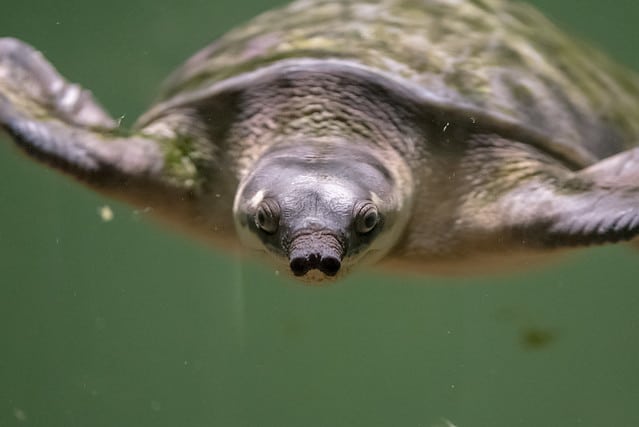
Pig-nose turtle is also known as the fly river turtle, a pitted-shelled turtle found in Australia and New Guinea. Both males and females are easily distinguished because the males have longer tails than female turtles.
It has a protruding nose called snout with long, wide, fleshy nostrils that look like the snouts of a pig, hence they are commonly named Pig-nose turtles. Interestingly, Their sense of smell is super that helps in finding food and can be used to breathe underwater.
Pig-nosed turtles are famously known as they are the only freshwater turtles to have flippers that are usually present in the marine turtles.
Manatee
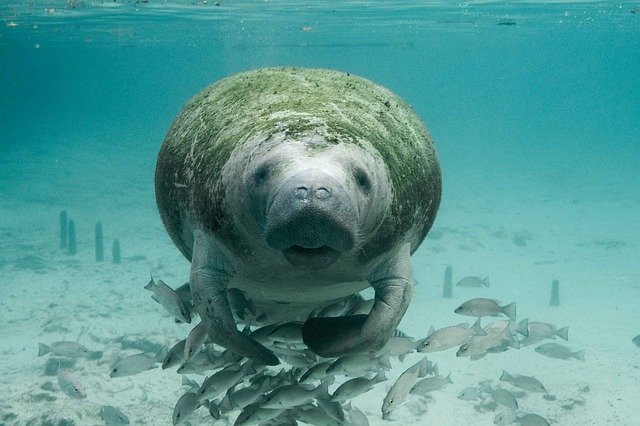
Manatees including the Amazonian manatee, the West Indian manatee, and the West African manatee are known as sea cows; they are mostly herbivorous marine animals that usually feed on the plants growing in freshwater and saltwater. Interestingly, they weigh about 600 Kg. That’s ok for marine mammals. Right!
Manatees don’t have gills like fish even though they live in the water, But as a marine mammal, They usually breathe through nostrils located at the end of a large projecting nose called snout that can be closed automatically under the water.
When they inhale at the surface of the water, about 90% of the air in its lungs is refreshed, Whereas in humans it’s about only 10% that’s their super adaptation as they live underwater for longer times, about 15 minutes.
Blobfish
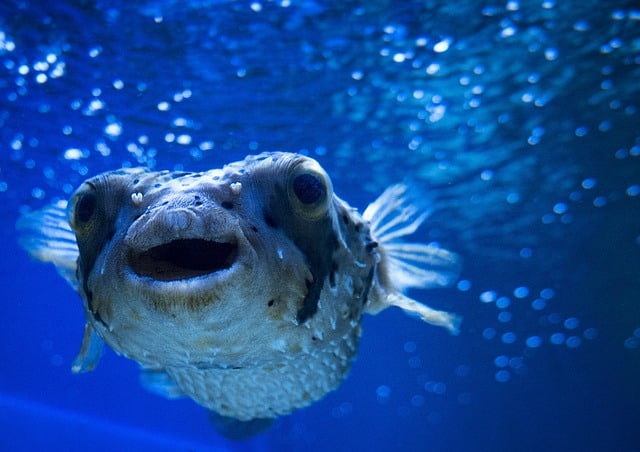
The next animal actually doesn’t have a nose but a nose like structure.
Blobfish, also known as the smooth-head blobfish, is a deep-sea fish living about 4,000 feet deep in the ocean and found in deep waters of Australia, Tasmania, and New Zealand.
They don’t actually have a nose, nostril, and even lungs but have a nose-like part on their head that appears when they are taken outside the water. Instead of skeleton and muscle they have jelly-like skin that expands under low pressure.
A floppy nose is not actually a nose but it’s a loose, puffy skin that looks like a nose.
Sawfish
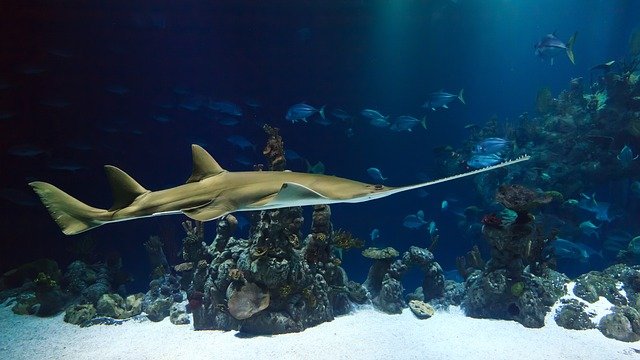
Sawfishes, also known as carpenter sharks, belong to a family of fishes that usually have flat and long snouts with teeth and are found in Africa, New York, the Caribbean, Gulf of Mexico.
They have a mouth and nostrils underside of their flat head with a protrusion snout called rostrum is a long flat nose-like structure lined with sharp transverse teeth that look like a saw.
These saw-shaped modified snout or rostrum have ampullary pores sensitive to the electric field that aid in detecting and locating the nearby animals, prey, predators and also useful for communicating with other sawfish.
Longnose gar

The longnose gar is also known as longnose garpike, billy gar is actually a bony fish belonging to a ray-finned fish family Lepisosteidae and is found in North America, eastern United States, Florida, etc.
We can see a needle-shaped snout, which is actually a modified jaw lengthwise that can reach three times the length of its head. They are called longnose gars as they have a slender and long shaped snout.
Long nosed chimaera
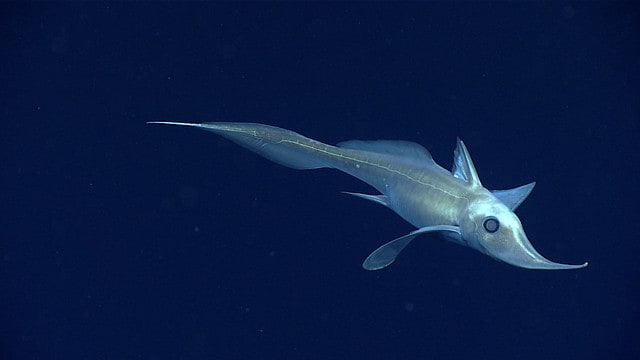
Long-nosed chimaera is a cartilaginous fish living in the 500-6,000 feet depth of the sea and found all over the world except the Antarctic . After reaching adult stages they will be about 6 m in length, large heads with nostrils, and have large green eyes that can see in the deep and dark oceans.
As their name ‘Long-nosed chimaera’ indicates, they have a long and conical-shaped snout with numerous sensory receptors for finding fishes.
Elephant Seal
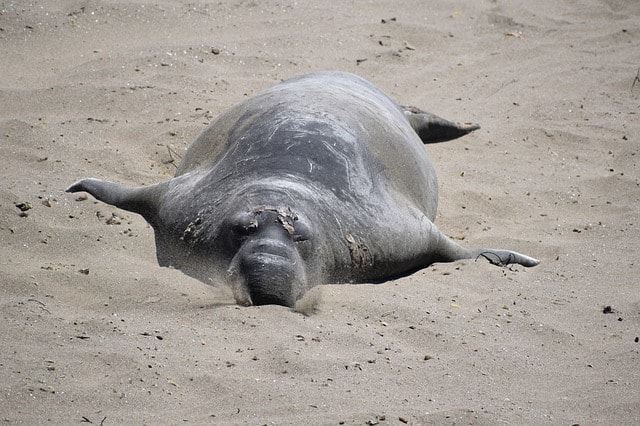
Elephant seals include the northern elephant seal and the southern elephant seal are large carnivores that could weigh about 4,000 Kg found in the regions of Alaska, Mexico, California, Mexico, etc.
Male seals develop a nose that looks like an elephant’s trunk that is named as ‘proboscis’ can be used to make louder sounds to ward off the other male competitors while attracting a female mate and are also used to absorb the moisture.
Elephant seals are called so because they look so when its nose is inflated to attract mates, show dominance, communicate, control territory, etc.
Wild Animals with Big Noses
Elephant
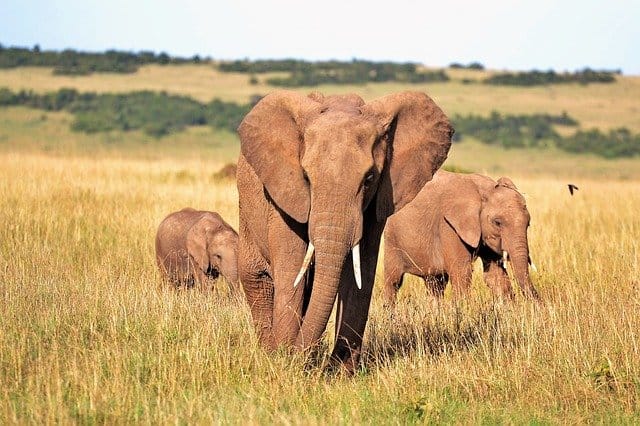
The next animal with long noses is the Elephant and is the largest land mammal that is herbivorous in diet found in sub-Saharan Africa, South Asia, Southeast Asia, etc.
They have a long and muscular nose with many olfactory receptors, usually known as the trunk that could weigh about 130 Kg and can lift the 250 Kg weighing objects. A trunk can reach about 6-8 feet in length with more than 40,000 muscles, a nostril of 2 inches in diameter.
Elephants can smell the water location that is about 12 miles away from them and can be used for many purposes such as smelling, breathing, trumpeting, drinking, grabbing, holding objects, etc.
Next Small animal with big nose is actually a monkey. Let’s know why it is so.
Proboscis Monkey

The proboscis monkey is also known as a long-nosed monkey, Nosy Monkey is a monkey with quite a large nose belonging to old world monkeys found in Borneo, the Asian region, Brunei, Indonesia, and Malaysia, etc.
It is fondly called the Nosy monkey whose nose can reach about 7 inches, that is used in vocalization, especially in males, can produce louder honks, amplify calls to attract the female mates.
Among the primates, proboscis monkey is the only primate with the longest nose -7 inches. That’s Amazing. Right!
Southern Tamandua
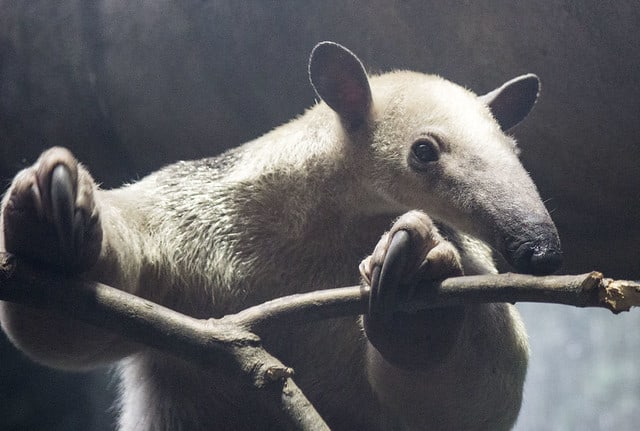
The southern tamandua is also known as the collared anteater, lesser anteater is a solitary mammal and a species of anteater found in South America, Argentina, southern Brazil, Caribbean.
They have a long and tapering snout through which a 12-16 inches tongue can pass to catch ants, termites, and sometimes bees. These snouts have a powerful sense of smell.
Tamandua use their elongated snout and tongue designed so as to get inside the termite mounds easily to slurp up prey.
Mandrill
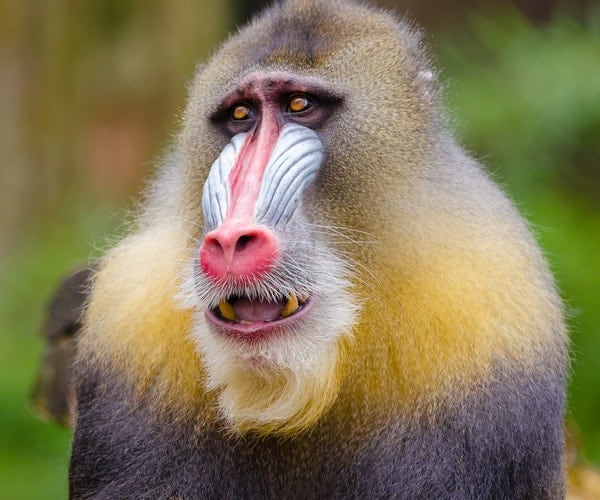
The mandrill is the largest monkey in the world that belongs to the old-world monkey found in Cameroon, Gabon, Guinea, and Congo. They are usually confused with baboons but actually belong to a different species of monkeys called Mandrillus.
They have a big prominent nose with thick ridges that have red-pink and white on them. The size and color of its nose are helpful in building dominance, attracting female mates.
Hippopotamus
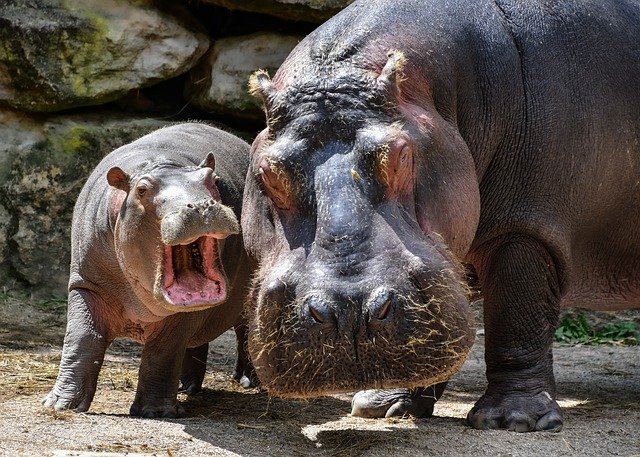
The next animal with a big nose is the third largest land mammal in the world after the rhinos and the elephant is the hippopotamus.
The hippopotamus is also known as simply hippos, common hippopotamus, river hippopotamus is a mammal adapted for both water and terrestrial life found in Uganda, Tanzania, Kenya, Ethiopia, Somalia, Sudan, Gambia, and Africa.
They have a big head with a prominent nose located at top of their head which enables easy breathing when they are submerged in the water and also close their nose along with ears to prevent the entry of water.
River Horse: They are called river horses as they usually thrive under the water and can hold their breath for about five minutes.
Malayan Tapir

Our next lovely animal with a big nose is Tapir, which looks like a mini version of the elephant as their nose looks and functions more or less like the elephant’s trunk.
The tapir including the South American tapir, the Malayan tapir, Baird’s tapir, and the mountain tapir, is a large pig resembling mammal with a long prehensile nose found in South America and Central America, and Southeast Asia.
They have a long prehensile nose (prehensile: capable of grasping) that is similar to an elephant trunk but small in size, also is similar to the big nose of an aardvark, through this type of nose they can grasp, wrap, pull, hold the branches, foods, fruits, etc.
If tapirs can’t face a threat, they simply hide underwater while using its long nose like a snorkel, until the threat passes away.
Aardvark

The aardvark is a nocturnal mammal that inhabited grasslands, savannas, rainforests, woodlands, Sahara, that are found in Africa.
They don’t have good eyesight but instead, a long pig-like snout meant for sniffing the food, with a better sense of smell enables them to seek to locate food sources.
These are awkward-looking creatures as they have a pig-like nose that is a long snout, rabbit-like long ears, a long tail that resembles the tail of a kangaroo.
Pig
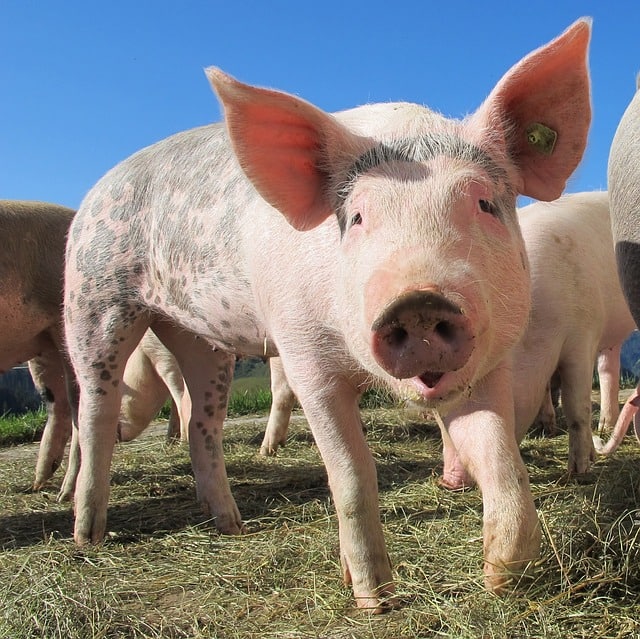
A Pig including all other kinds is an omnivorous mammal distributed throughout the world and is used as food.
They have a relatively large and long head that ends with a strong, blunt shaped snout with two nostrils that are used for digging, moving objects, searching for food, and even fighting through the snout with the other male for gaining female mates.
They have an amazing sense of smell making them one of the extremely smart animals.
Anteater

Anteaters including Giant anteater, Silky anteater, etc. is a toothless mammal chiefly feeds on ants, termites and is found in Mexico, Paraguay, Argentina, etc.
They have a tapering head with a long snout that is better at smell detection. Thus while finding food, they rely on its snout and smell detecting abilities as they have poor eyesight and small ears.
Sense of Smell: It has a better sense of smell, 40 times better than humans.
Saiga Antelope
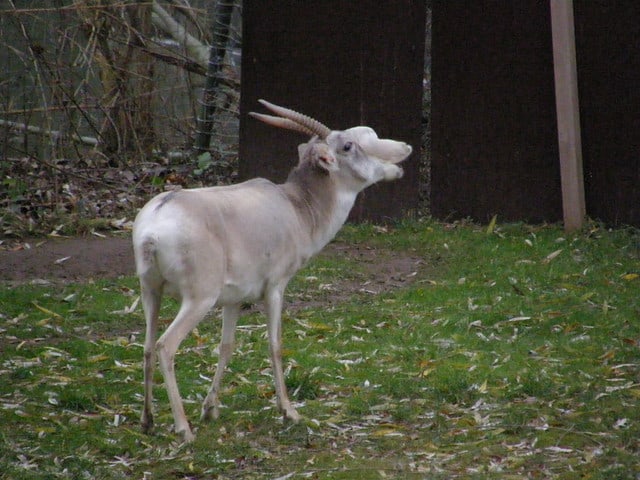
Next animal with a big nose is a large herbivore mammal called Saiga antelope found in Mongolia, Turkmenistan, Uzbekistan, and other parts of Central Asia.
Saiga has a prominent pair of closely spaced nostrils in a downward direction. In summer, Its nose helps in keeping dust away while also cools the warm air. Whereas in winter, Its long snout warms the air.
Inflatable Nose: They have an inflatable nose that can cool the animal body in summer.
Animals with Weird Noses
Star nose mole
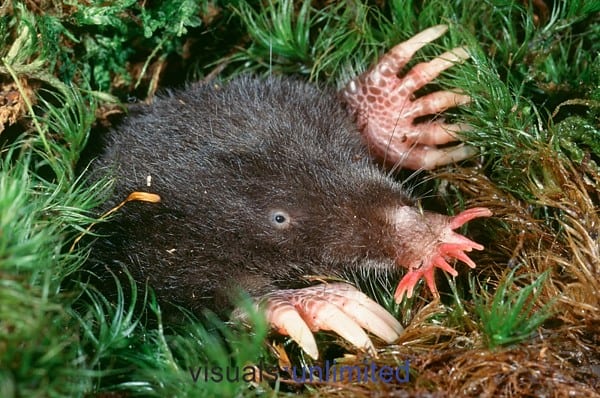
The star-nosed mole is a small mole that has a weird nose and poorly developed eyes found in North America.
They have a weird-looking nose with more than 25,000 tiny sensory receptors, known as Eimer’s organs, seismic wave vibrations. As they are blind thus rely on the snout that can be used to detect electrical activity in prey animals. These moles can smell underwater through the air bubbles and scents dissolved in water.
Fastest-eating mammal: It takes only about 120 milliseconds to identify the capture object as food or not, if so it’ll eat them fast.
Goblin Shark

Next Water animals with big noses is the ‘Goblin shark’. It is a shark living about sea-depths about 4,000 feet in depth found in the Gulf of Mexico, French Guiana, Brazil, France, Portugal, Madeira, etc.
They have an elongated snout that comes out through a protrusible jaw, also covered with ampullae of Lorenzini that can detect prey through changes in the electric field due to prey movements. These snouts don’t have nostrils, thus they breathe through gills.
Goblin shark small eyes and ampulla tune together to find food.
Hammerhead Shark
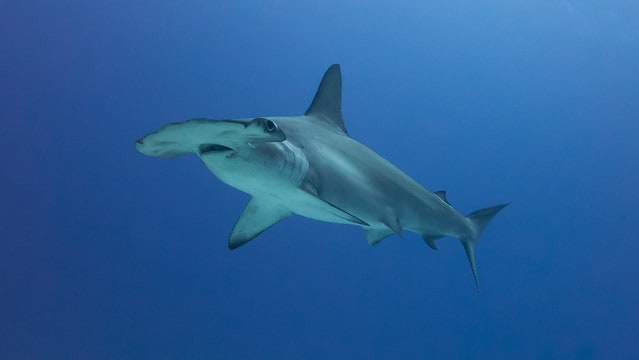
The hammerhead shark has a unique type of head with binocular vision which enables them better vision of the undersea world.
They have unusual heads that are flat and hammer in shape, with binocular vision. These heads have flattened snouts with far located nostrils that help in detecting prey quickly. While these sharks swim, water flows into nostrils which can detect scent, proteins, pheromones, and blood through their receptors.
Sound sensitive: They can analyze the sound and sound sources located about miles away.
Pinocchio lizard
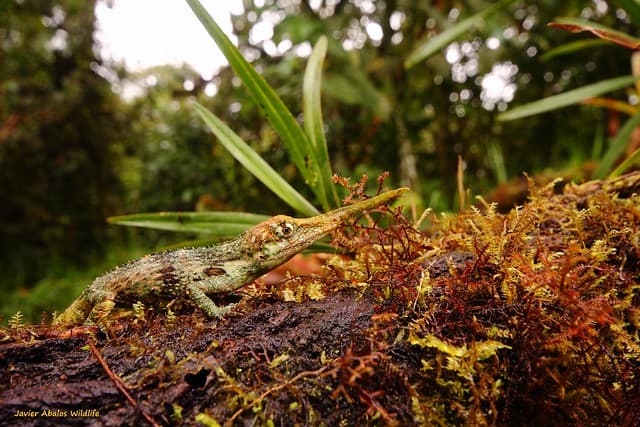
Pinocchio lizard is also known as the Proboscis anole, Ecuadorian horned anole is a small lizard with a weird horn called a proboscis.
The males of a Pinocchio lizard have a distinct proboscis which is an elongated structure that emerged from the snout which is about 2 cm in length.
The hatched baby reptile Pinocchio lizard from its eggs is also equipped with a small horn. Whereas other kinds of horned lizards usually grow their horns after hatching.
What animal has a long nose? There are many animals but Let’s see the Gharial with a long nose.
Gharial

The gharial is also known as the gavial, the fish-eating crocodile that is found in Bangladesh, Bhutan, India, Myanmar, Nepal, etc.
These fish-eating crocodiles have a long and thin snout with a boss at their tips and about 100 teeth. There are many sensory cells present on the snouts that can detect vibrations produced by prey.
Its thin and long snout have less resistance against the fast-flowing water thus they can catch their prey, fishes easily in fast-flowing water.
Duck-billed platypus

The platypus is also known as the duck-billed platypus is a small-sized egg-laying placental mammal which is also a semiaquatic animal found in some regions of Tasmania, Australia, etc.
These have elongated snouts along with lower jaw form bills that have an electrolocation feature. However, It also has a nostril on its dorsal bills.
While diving into the water, its ears, nose, ears are closed, But at the same time, its electrolocation feature comes into play as it keeps swimming to find prey.
Also Read : Animals with big cute Ears
Why do Proboscis Monkeys have Big Noses?
Usually, Males proboscis monkey have a larger nose that plays many important roles such as
- Enhances the quality of mating calls.
- Increases the attractiveness of them(males).
- Show dominance.
- Increases the chance of mating as the females are more attracted to the monkeys with large noses.
Proboscis monkeys usually live in groups ranging between 3-60, No notable aggression is seen in them, If so it is a minor one. As you might guess, Aggression is common, especially in a pack of animals including monkeys which contain small babies, and juveniles show aggression to protect them. However, They are not dangerous until provoked or threatened. For example, While Humans laughing they feel threatened as they see human teeth.
Noticeable behavior in proboscis monkeys is their warning calls and mating calls that are amplified by their large noses to show dominance, attract female mates.
What Animal has the Largest Nose in the World?
The sperm whale is a mammal with the largest nose in the world. It has a blowhole and is actually a modified left nostril that is located at the frontal area of the snout. However, The right nostril of its nose is not as advanced as the left nostril.
